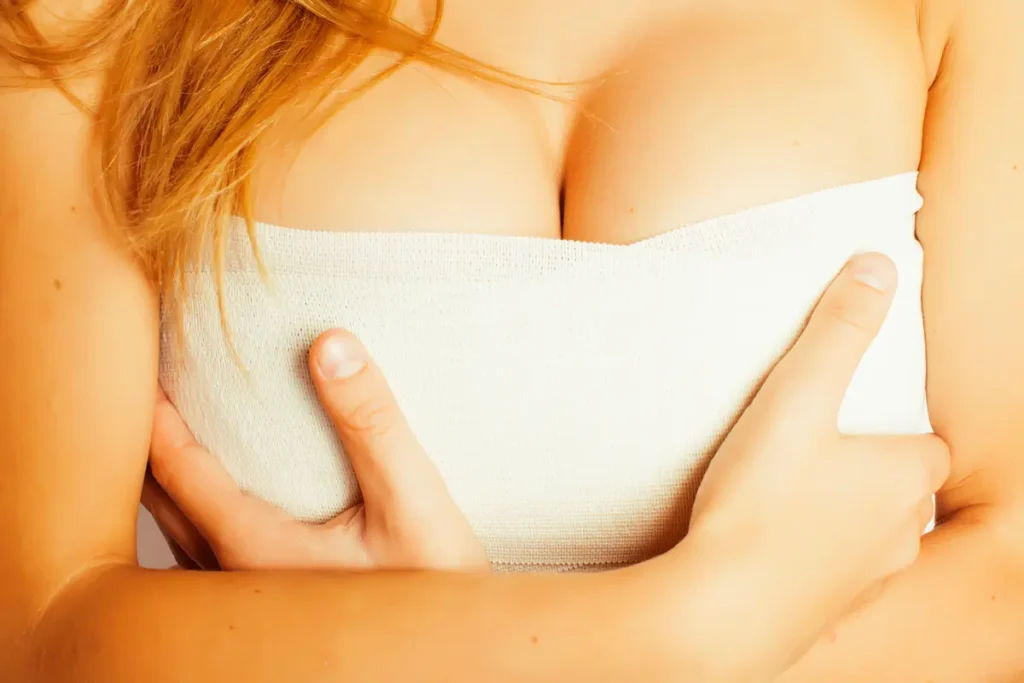What is Fat Transfer Breast Augmentation?
Fat transfer breast augmentation, also known as “fat grafting” breast augmentation, autologous fat transfer or micro-lipoinjection, is a procedure that has been gaining popularity as an alternative to traditional breast augmentation with the placement of an implant.
The trend towards a more natural “ballet body” physique has led to an increased interest in procedures that offer subtle enhancements, including fat transfer techniques. In 2024, about 25% of breast augmentation procedures involve fat transfer, either alone or in combination with an implant.
Fat transfer breast augmentation uses a patient’s own fat cells to enhance the size and shape of the breasts and has gained popularity due to its natural look and feel. While the patient is under anesthesia, a small cannula is used to remove unwanted fat from areas of the body through liposuction. The fat is then processed and purified before being injected into the breasts. Scarring is minimal and nearly undetectable once healed.
If you’re considering fat transfer as an option for breast augmentation, it’s essential to have realistic expectations about the outcome and to consult with a board-certified plastic surgeon who has extensive experience in this technique.
Here’s how to make an informed decision about whether this procedure is right for you.
Best Candidates for Fat Transfer Breast Augmentation
Fat transfer breast augmentation is somewhat less predictable and controllable than traditional breast augmentation with implants. The leading indicators of success involve the patient’s current natural breast size, the cup size desired, laxity of the breast tissue and quality of the skin.
Let’s visualize a breast as a honeycomb matrix, and let’s imagine that we can put one drop into each cell.
If you have a smaller breast, such as an “A” cup, you’ll only be able to put a small number of drops in, resulting in very little change. However, if you have a fair amount of volume already, like a “C” cup or greater, you can put more drops in and see a more appreciable amount of change.
For a patient with breasts that are large, but have more laxity and tend to droop, a breast lift may be required along with the fat transfer. This can work tremendously well, depending on your goals.
The amount of gain in a fat grafting breast augmentation is quite modest compared to the precise size and shape of a breast implant.
Sometimes, people believe they can gain weight and use their “new” fat for a fat transfer. The problem with this strategy is that the newly transferred fat cells can shrink back in size as a patient loses weight.
Even under the best circumstances, the amount of gain or increase in a fat grafting breast augmentation is still quite modest compared to the precise size and shape that can be achieved with an implant.
Let’s look at the pros and cons of breast augmentation with this method.
Pros of Fat Transfer Breast Augmentation
One of the main advantages of fat transfer breast augmentation for women is that it uses the patient’s own fat cells, which eliminates the risk of an allergic reaction or rejection.
Another advantage is that it can be used to correct asymmetry. This means that if one breast is larger or smaller than the other, the surgeon can use fat grafting to even out the size and shape of the breasts. This can create a more balanced and natural look.
In addition to correcting asymmetry, fat grafting can also be used to improve the shape of the breasts. This procedure can be used to add volume and fullness to the breasts, creating a more youthful and attractive appearance. Fat grafting can be a great option for someone starting with a C cup or greater but can be a considered option for any natural breast size.
For example, by placing the fat along the upper portion of the breast, upper pole fullness can be achieved in an otherwise natural, unaugmented breast. Additionally, the surgeon can shape the breast to be more round or implant-like while building up a beautifully sloped profile of the breast.
Another advantage of fat grafting for someone with a fuller breast is that there is no maintenance required, unlike breast implants which may fail or need to be changed. This can be a plus for anyone who wants to avoid the risks and costs associated with implant replacement surgery in the future.
Cons of Fat Transfer Breast Aug
One of the main disadvantages of fat transfer breast augmentation is that you may not get as much of a change or the volume that you want. This is because the procedure is limited by the amount of fat that can be safely removed from your body at the donor site and the amount of volume that your breasts can hold. This can be a disappointment for some people who are looking for a significant change in size.
This is another reason multiple procedures may be needed to achieve the desired results.
Complimentary Consultation
Dedicated to using the highest standards of care for our patients, call today to discover how our Beautiful and Natural Results can enhance your hourglass figure.
Additionally, the amount of fat that survives the transplantation process can vary. This should be taken into consideration by the surgeon when determining the amount of fat to be transferred during surgery.
A portion of the transferred fat cells may also get reabsorbed by the body, and the size of the cells may fluctuate in size as the individual gains or loses weight. These reasons can make the outcome less predictable than someone who elects to have breast enlargement surgery with an implant.
Another downside of fat grafting is that it can create some scarring or calcification in the breast (as can also happen in a breast reduction or a breast lift). Fortunately, the scarring and calcification caused by fat grafting is very different from breast cancer calcification, and most mammography radiologists are adept at telling the difference.
Recovery for Fat Transfer Breast Aug
The recovery process from a fat transfer procedure will vary depending on the individual and the specific technique used by the surgeon.
Generally speaking, the recovery time for a fat grafting procedure can range from a few days to a few weeks. In most cases, patients may return to an office setting-type position or work from home within a day or two. For jobs that require heavy lifting or strenuous activity, more time to heal may be necessary.
The patient may experience some mild pain and discomfort during the initial recovery period, but this can be managed with pain medication prescribed by the surgeon.
After the procedure, patients will be required to wear a compression garment to help reduce swelling at the incisions at the liposuction sites and to help support the newly augmented breasts.
The surgeon will give you specific instructions on how long you will have to wear the compression garment, which usually is typically just a few weeks.
You may experience some swelling, bruising, and numbness in the treated area, but these symptoms should subside within a few days. It’s important to follow the post-operative instructions given by the surgeon for reducing swelling, preventing infection, and promoting healing.
Patients will typically be able to return to normal activities within a week or two after the procedure, but it’s important to avoid strenuous exercise and heavy lifting for at least a month. Your restrictions will be discussed with you prior to surgery to allow you time to make arrangements if required.
The final results of the procedure will not be visible immediately, and it may take several weeks or even months for the grafted fat to fully settle and for the final results to become visible.
Overall, the recovery process from a breast fat transfer procedure is relatively short and manageable with proper care. The patient should follow the surgeon’s instructions and keep in mind that the final results may take several weeks or months to be visible.
Combination Procedures
Fat transfer breast augmentation is often done in conjunction with other procedures to achieve a more comprehensive and satisfying result. One popular combination is liposuction, which can be used to sculpt the body and remove unwanted fat before it is used to augment the breasts. This not only enhances the breast volume and shape, but also helps to achieve a more contoured and proportionate overall figure.
Another popular combination is a breast lift or breast reduction. These procedures can help to improve the shape, position and symmetry of the breasts. Fat transfer breast augmentation can be used to fill any volume losses and provide a more natural and youthful appearance.
Breast lifts or breast reductions are popular combination procedures often done in conjunction with fat transfer breast augmentations.
Dr. Stephan Ronan
Fat transfer breast augmentation can also be used to fill traumatic defects or defects created during prior liposuction procedures. This technique can be used to correct asymmetry, restore volume, and improve the overall appearance of the breast.
It’s important to note that each individual case is unique and that a board-certified plastic surgeon will be able to evaluate you and recommend the best combination of procedures, if any, to achieve the desired outcome. Combining procedures can provide a more comprehensive and satisfying result, but it’s important to have realistic expectations and to weigh the risks and benefits of each procedure before making a decision.
Consult a Board-Certified Plastic Surgeon
Fat transfer breast augmentation can provide a natural look and feel, but it also has some disadvantages, such as potentially requiring multiple procedures, less predictable long-term results than implants, and attendant higher costs. It’s important to consider all these factors when deciding to undergo fat transfer breast augmentation or not.
The best way to know if fat transfer breast augmentation is right for you is to consult a board-certified plastic surgeon, who will evaluate your individual situation and give you professional advice. Remember that the final results may take several weeks or months to be visible, and maintain realistic expectations about the procedure and its outcomes.
FAQ for Fat Transfer Breast Augmentation
What’s the Difference Between “Fat Transfer” and “Fat Grafting”?
In the context of plastic surgery, “fat transfer” and “fat grafting” are often used interchangeably to refer to the same procedure. The basic process of both terms is removing fat from one area of the body, such as the abdomen or thighs, and injecting it into another area, such as the breasts, to add volume and shape.
“Fat transfer” is a more general term that refers to the process of moving fat from one area of the body to another, while “fat grafting” is more specific and refers to the process of injecting fat into the breast to add volume and shape. Both terms are used to refer to the procedure, but some doctors may prefer one term over the other.
Complimentary Consultation
Dedicated to using the highest standards of care for our patients, call today to discover how our Beautiful and Natural Results can enhance your hourglass figure.
Additional Helpful Links
- American Society of Plastic Surgeons (ASPS) – Fat Grafting: https://www.plasticsurgery.org/cosmetic-procedures/fat-transfer-breast-augmentation This link provides comprehensive information on fat transfer breast augmentation, including procedure details, risks, and expected results, from a reputable professional organization.
- Cleveland Clinic – Fat Grafting for Breast Augmentation: https://my.clevelandclinic.org/health/treatments/24033-fat-transfer-breast-augmentation This article from WebMD discusses the pros and cons of fat transfer breast augmentation, and helps patients understand the procedure in the context of other augmentation options.
Additional Cosmetic Procedures
While fat transfer breast augmentation is an excellent option for many patients, Blackhawk Plastic Surgery & MedSpa offers a comprehensive range of cosmetic procedures to address various aesthetic concerns. Our expertise extends beyond breast augmentation to include facial rejuvenation and body contouring treatments.
For those looking to address signs of aging in the face, we offer a variety of injectables and facial treatments. Botox and Dysport injections can help smooth out fine lines and wrinkles, particularly around the eyes and forehead. Dermal fillers such as Juvederm and Restylane, which contain hyaluronic acid, can restore volume to the cheeks and lips and address deeper folds in the skin. These treatments can provide a rejuvenating effect without the need for more invasive procedures like facelifts.
Our skilled staff is also trained in collagen stimulation treatments and other advanced techniques to improve facial structure and contours. Whether you’re concerned about the appearance of your hands, seeking to enhance specific facial features, or interested in exploring options for overall facial rejuvenation, our team can tailor a treatment plan to your individual needs. From addressing muscle-related concerns to improving skin texture, we offer a range of solutions to help you achieve your aesthetic goals.
By combining our expertise in breast augmentation with these additional cosmetic procedures, we strive to provide comprehensive care that enhances your natural beauty and boosts your confidence. During your consultation, our board-certified plastic surgeon will discuss your concerns and recommend the most suitable treatments to achieve your desired results.



